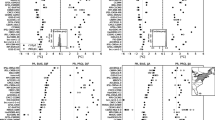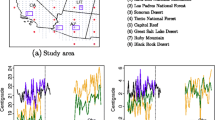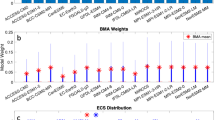Abstract
Ensembles of historical climate simulations and climate projections from the World Climate Research Programme’s (WCRP’s) Coupled Model Intercomparison Project phase 3 (CMIP3) multi-model dataset were investigated to determine how model credibility affects apparent relative scenario likelihoods in regional risk assessments. Methods were developed and applied in a Northern California case study. An ensemble of 59 twentieth century climate simulations from 17 WCRP CMIP3 models was analyzed to evaluate relative model credibility associated with a 75-member projection ensemble from the same 17 models. Credibility was assessed based on how models realistically reproduced selected statistics of historical climate relevant to California climatology. Metrics of this credibility were used to derive relative model weights leading to weight-threshold culling of models contributing to the projection ensemble. Density functions were then estimated for two projected quantities (temperature and precipitation), with and without considering credibility-based ensemble reductions. An analysis for Northern California showed that, while some models seem more capable at recreating limited aspects twentieth century climate, the overall tendency is for comparable model performance when several credibility measures are combined. Use of these metrics to decide which models to include in density function development led to local adjustments to function shapes, but led to limited affect on breadth and central tendency, which were found to be more influenced by “completeness” of the original ensemble in terms of models and emissions pathways.
Similar content being viewed by others
References
AchutaRao K, Sperber KR (2002) Simulation of El Niño Southern Oscillation: results from the coupled model intercomparison project. Clim Dyn 19:191–209
AchutaRao K, Sperber KR (2006) ENSO simulation in coupled ocean–atmosphere models: are the current models better. Clim Dyn 27:1–15
AchutaRao KM, Covey C, Doutriaux C, Fiorino M, Gleckler P, Phillips T, Sperber K, Taylor K (2004) An appraisal of coupled climate model simulations, D Bader (ed), Rep. UGRL-TR-202550, 183pp, Program for climate model diagnosis and intercomparison. Lawrence Livermore National Lab., Livermore, California
Black PE (2006) (eds) Dictionary of algorithms and data structures. U.S. National Institute of Standards and Technology, Gaithersburg, MD
Brekke LD, Miller NL, Bashford KE, Quinn NWT, Dracup JA (2004) Climate change impacts uncertainty for water resources in the San Joaquin River basin. Calif, J Am Water Resour Assoc 40:149–164
Cayan DR, Maurer EP, Dettinger MD, Tyree M, Hayhoe K (2006) Climate change scenarios for the California region. Climatic Change (in press)
Christensen N, Lettenmaier DP (2006) Climate change and Colorado River Basin: Implications of the FAR Scenarios for Hydrology and Water Resources. poster presentation at the Third Annual Climate Change Research Conference co-sponsored by the California Energy Commission and California Environmental Protection Agency, September 13–15 2006
Covey C, AchutaRao KM, Cubasch U, Jones P, Lambert SJ, Mann ME, Phillips TJ, Taylor KE (2003) An overview of results from the Coupled Model Intercomparison Project (CMIP). Glob Planet Change 37:103–133
Dettinger MD (2005) From climate change spaghetti to climate change distributions for 21st century. San Franc Estuary Watershed Sci 3(1):1–14
Dettinger MD (2006) A component-resampling approach for estimating probability distributions from small forecast ensembles. Clim Change 76:149–168
Hayhoe K, Cayan D, Field C, Frumhoff P, Maurer E, Miller N, Moser S, Schneider S, Cahill K, Cleland E, Dale L, Drapek R, Hanemann RM, Kalkstein L, Lenihan J, Lunch C, Neilson R, Sheridan S, Verville J (2004) Emissions pathways, climate change, and impacts on California. Proc Natl Acad Sci (PNAS) 101(34):12422–12427
IPCC (Intergovernmental Panel on Climate Change) (2001) Climate Change 2001: The Scientific Basis. Contribution of Working Group I to the third assessment report of the IPCC, Houghton JT, Ding Y, Griggs DJ, Noguer M, van der Linden PJ, Dai X, Maskell K, Johnson CA (eds) Cambridge University Press, 881 pp
IPCC (2007) Climate Change 2007 – The Physical Science Basis. Contribution of Working Group I to the Fourth Assessment Report of the IPCC, Soloman S, Qin D, Manning M, Marquis M, Averyt K, Tignor MMB, Miller HL, Chen Z (eds). Cambridge University Press, 996 pp
Kalnay E, Kanamitsu M, Kistler R et al (1996) The NCEP/NCAR 40-year reanalysis project. Bull Am Meteorol Soc 77:437–471
Lall U, Rajagopalan BR, Tarboton DG (1996) A nonparametric wet/dry spell model for resampling daily precipitation. Water Resour Res 32:2803–2823
Mantua NJ, Hare SR, Zhang Y, Wallace JM, Francis RC (1997) A Pacific Interdecadal Climate Oscillation with Impacts on Salmon Production. Bull Am Meteorol Soc 78:1069–1079
Maurer EP (2007) Uncertainty in hydrologic impacts of climate change in the Sierra Nevada, California under two emissions scenarios. Clim Change 82:309–325
Maurer EP, Duffy PB (2005) Uncertainty in projections of streamflow changes due to climate change in California. Geophys Res Lett 32(3):L03704
McCabe GJ, Palecki MA, Betancourt JL (2004) Pacific and Atlantic Ocean influences on multidecadal drought frequency in the United States. Proc Natl Acad Sci 101:4136–4141
Meehl GA, Covey C, McAvaney B, Latif M, Stoufer RJ (2005) Overview of the coupled model intercomparison project. Bull Am Meteorol Soc 86:89–93
Milly PCD, Dunne KA, Vecchia AV (2005) Global pattern of trends in streamflow and water availability in a changing climate. Nature 438:347–350
Phillips TJ, AchutaRao K, Bader D, Covey C, Doutriaux CM, Fiorino M, Gleckler PJ, Sperber KR, Taylor KE (2006) Coupled climate model appraisal: a benchmark for future studies. EOS Trans 87:185
Piechota TC, Chiew FHS, Dracup JA, McMahon TA (1998) Seasonal streamflow forecasting in eastern Australia and the El Niño-Southern Oscillation. Water Resour Res 34:3035–3044
Scott DW (1992) Multivariate density estimation: theory, practice, and visualization. Probability and mathematical statistics. Wiley, New York
Silverman BW (1986) Density estimation for statistics and data analysis. Monographs on statistics and applied probability. Chapman and Hall, New York
Tebaldi C, Smith RL, Nychka D, Mearns LO (2005) Quantifying uncertainty in projections of regional climate change: a bayesian approach to the analysis of multi-model ensembles. J Climate 18:1524–1540
Vicuna S, Maurer EP, Joyce B, Dracup JA, Purkey D (2007) The sensitivity of California water resources to climate change scenarios. J Am Water Resour Assoc 43(2):482
Wilby RL, Harris I (2006) A framework for assessing uncertainties in climate change impacts: low-flow scenarios for the River Thames, UK. Water Resour Res 42:W02419
Wilks DS (1995) Statistical methods in the atmospheric sciences. Academic Press, New York
Zierl B, Bugmann H (2005) Global change impacts on hydrological processes in Alpine Catchments. Water Resour Res 41:W02028
Author information
Authors and Affiliations
Corresponding author
Rights and permissions
About this article
Cite this article
Brekke, L.D., Dettinger, M.D., Maurer, E.P. et al. Significance of model credibility in estimating climate projection distributions for regional hydroclimatological risk assessments. Climatic Change 89, 371–394 (2008). https://doi.org/10.1007/s10584-007-9388-3
Received:
Accepted:
Published:
Issue Date:
DOI: https://doi.org/10.1007/s10584-007-9388-3




